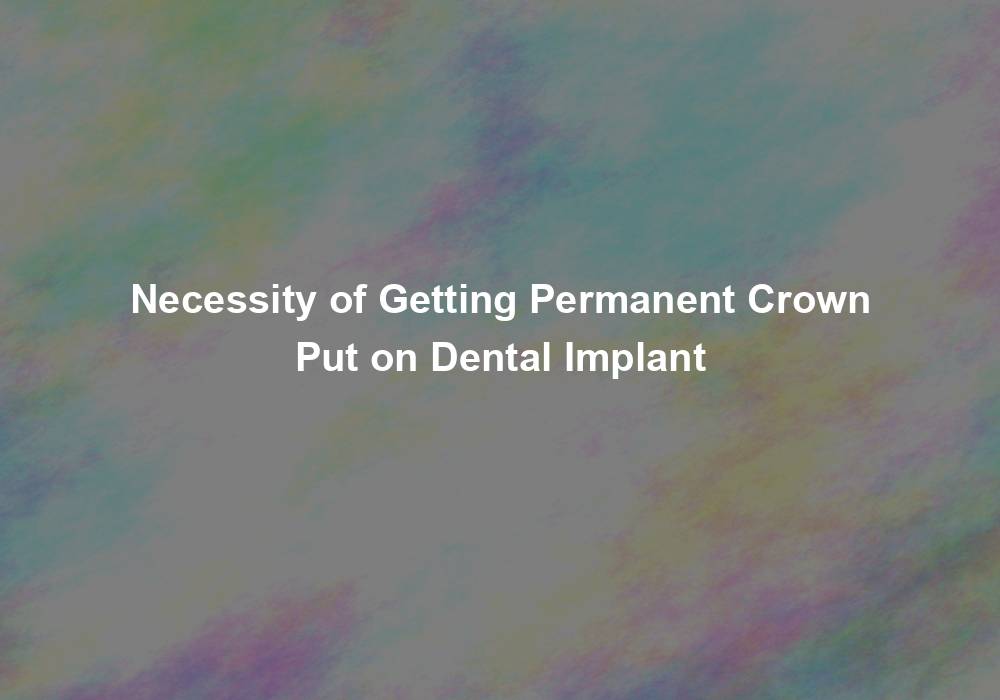Introduction
Dental implants have revolutionized the way we approach oral health, particularly in replacing missing teeth. These innovative devices not only restore function but also provide a cosmetically appealing solution. Central to their success is the placement of a permanent crown, a step that is as critical as it is necessary. This article delves into the importance of this final stage, exploring the technical and aesthetic reasons why a permanent crown on a dental implant isn’t just an option—it’s a necessity.
Understanding Dental Implants
Dental implants are a breakthrough in dental prosthetics, offering a long-term solution for missing teeth. Unlike dentures or bridges, implants involve a surgical procedure where a titanium post is inserted into the jawbone, acting as a synthetic tooth root. This post is then topped with an abutment, which in turn supports the final piece: the crown.
Unlike other dental replacements, implants mimic the structure of natural teeth, from root to crown, offering unprecedented stability and durability. The integration of the implant into the jawbone, a process known as osseointegration, is what sets this procedure apart, ensuring the implant remains firmly anchored.
Read: Materials Used in Dental Implants: A Comparison
The Role of the Permanent Crown
The permanent crown is the visible part of the dental implant, meticulously crafted to match the color, shape, and size of the surrounding natural teeth. This customization ensures that the implant is indistinguishable from other teeth, both in function and appearance.
Functionally, the crown restores the ability to chew and speak properly. It distributes bite forces evenly across the jaw, preventing issues like bone loss or the shifting of adjacent teeth. Aesthetically, it completes the smile, restoring confidence and improving overall quality of life.
Risks of Delaying or Avoiding Crown Placement
Neglecting to place a permanent crown can lead to several complications. Firstly, without the crown, the implant lacks its protective cover, leaving it susceptible to damage. This exposure can also lead to infections, impacting oral health.
Moreover, a missing crown disrupts the balance in the mouth. It can cause adjacent teeth to shift, potentially leading to misalignment and bite issues. Over time, this can necessitate more extensive dental work, incurring additional costs and discomfort.
The Procedure for Placing the Crown
Placing the crown is a meticulously planned procedure. After ensuring the implant has fully integrated with the bone—a process that can take several months—the dentist fits the abutment. The crown, made from durable materials like porcelain or ceramic, is then attached.
Patients can expect minimal discomfort during this procedure, often less than what they experienced during the implant placement. Post-procedure, some might experience mild sensitivity, which typically subsides quickly.
Care and Maintenance of the Crown and Implant
Maintaining the longevity of the implant and crown is crucial. Regular brushing and flossing, along with routine dental check-ups, are key. Although the crown itself cannot decay, the surrounding gum and bone are still susceptible to disease, making oral hygiene paramount.
Read: Steps to Take if Your Dental Implant or Crown Loosens or Falls Out
Success Rates and Patient Outcomes
The success rate of dental implants with crowns is impressively high, often cited at over 95%. This success is reflected in the stories of countless patients who have regained not just their smile but also their ability to enjoy various foods and speak without hindrance.
Conclusion
The placement of a permanent crown on a dental implant is not merely a procedural step—it is a crucial component that completes the journey towards a restored smile and optimal oral health. By understanding the importance of this step, patients can make informed decisions and enjoy the full benefits that dental implants have to offer. As with any medical procedure, consultation with a qualified dental professional is essential for personalized advice and care.
Frequently Asked Questions About Permanent Crowns on Dental Implants
1. What is the lifespan of a permanent crown on a dental implant?
- A permanent crown on a dental implant typically lasts between 10 to 15 years, depending on factors like material quality, oral hygiene, and lifestyle habits. Regular dental check-ups and good oral care can extend its lifespan.
2. Can the color of the permanent crown be matched to my other teeth?
- Absolutely. Permanent crowns are custom-made to match the color of your natural teeth. Your dentist will use a shade guide to ensure the crown blends seamlessly with your surrounding teeth for a natural look.
3. Is the process of getting a permanent crown painful?
- The procedure to place a permanent crown is generally not painful. Most patients report minimal discomfort. Local anesthesia is used during the procedure to ensure comfort, and mild sensitivity post-procedure is normal but temporary.
4. How do I care for my dental implant and permanent crown?
- Care for your dental implant and crown just as you would your natural teeth. This includes regular brushing twice a day, flossing daily, avoiding hard or sticky foods, and attending regular dental check-ups and cleanings.
5. What are the signs that my dental implant or crown needs to be replaced or repaired?
- Signs that your implant or crown may need attention include discomfort or pain in the implant area, difficulty chewing, swelling or inflammation of the gums, a loose or shifting crown, and noticeable wear or cracks in the crown. If you experience any of these symptoms, consult your dentist immediately.
